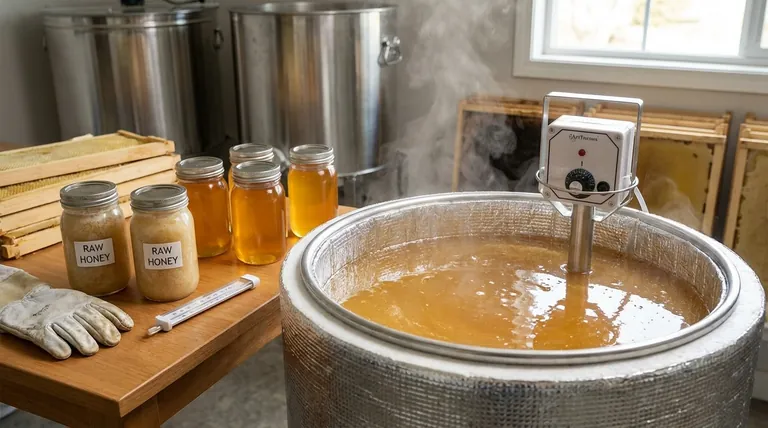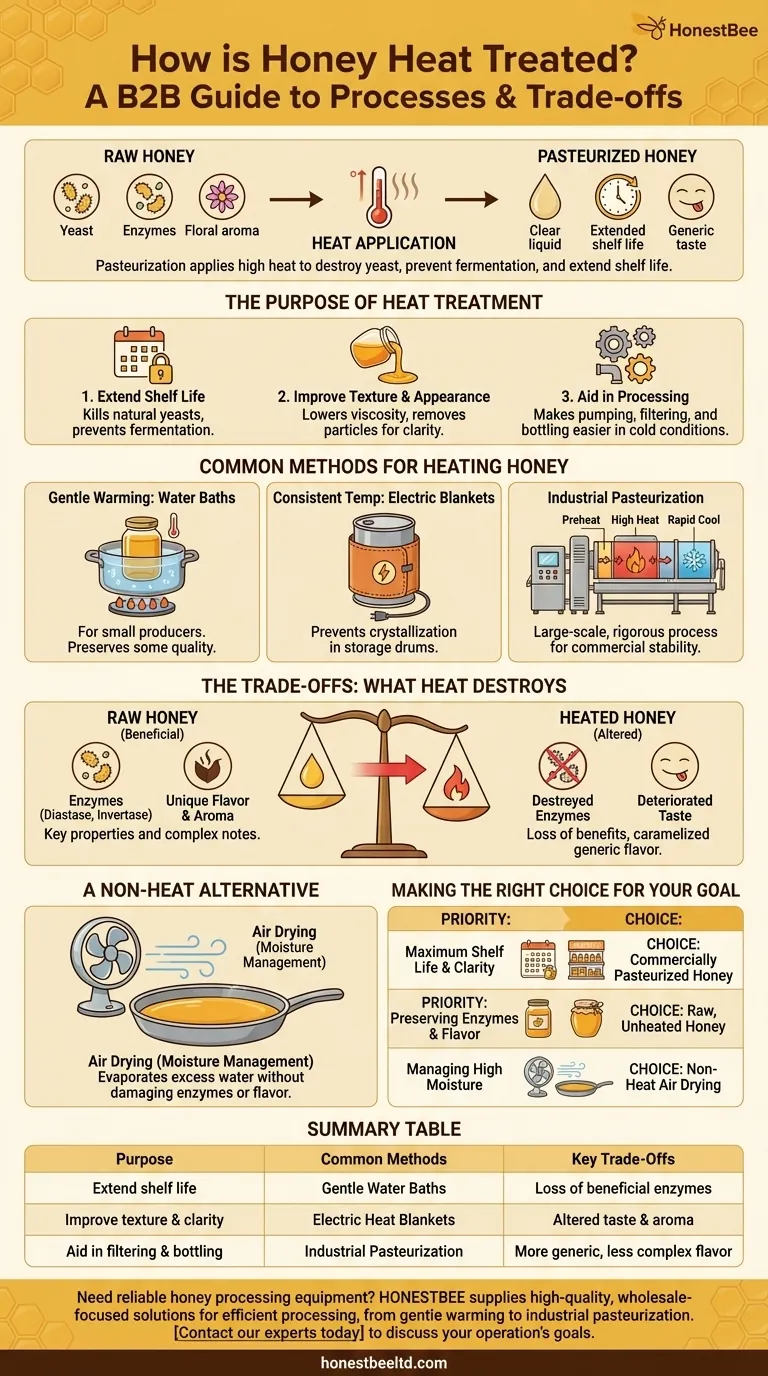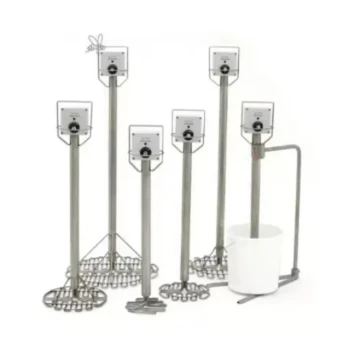In short, honey is heat-treated through a process called pasteurization, which involves applying high heat to destroy yeast, prevent fermentation, and extend its shelf life. Common methods for applying this heat include gentle water bath heaters or industrial preheating systems, which make the honey smoother, clearer, and easier to filter and bottle.
The central purpose of heating honey is to achieve a stable, clear, and long-lasting commercial product. However, this convenience comes at a significant cost: the destruction of beneficial enzymes and the alteration of the honey's natural taste and aroma.

The Purpose of Heat Treatment
Understanding why honey is heated is key to understanding the difference between a raw, natural product and a processed one. The goals are almost entirely focused on commercial viability and consumer aesthetics.
Extending Shelf Life
The primary reason for heat treatment is pasteurization. Raw honey contains natural yeasts which, if the moisture content is high enough, can cause the honey to ferment over time. Applying high heat kills these yeasts, effectively preventing fermentation and giving the honey a much longer, more stable shelf life.
Improving Texture and Appearance
Heating significantly lowers the viscosity of honey, making it runnier and smoother. This heat, combined with filtration, removes fine particles, wax, debris, and air bubbles. The result is the perfectly clear, liquid honey that consumers are accustomed to seeing on supermarket shelves, which remains liquid for longer before crystallizing.
Aiding in Processing
From a practical standpoint, gently warming honey is often necessary for processing. In colder months or with naturally thick honey, preheating makes it possible to pump the honey through pipes, filter it effectively, and bottle it without difficulty.
Common Methods for Heating Honey
The method and intensity of heat application vary depending on the scale of the operation, from a small-scale beekeeper to a large industrial plant.
Gentle Warming: Water Baths
For hobbyists or small producers, a water bath heater is a common choice. This method gently warms the honey container without applying direct, scorching heat. This is often used simply to make the honey workable while aiming to preserve as much of its natural quality as possible.
Consistent Temperature: Electric Blankets
Electric heat blankets are another method used to maintain a consistent, low temperature. These are particularly useful for preventing thick honey from crystallizing in storage drums during cold weather, ensuring it remains ready for bottling.
Industrial Pasteurization
In a large-scale commercial workflow, honey undergoes a more rigorous process. It typically involves preheating to make the honey flow, followed by fine filtration and then a rapid, high-heat pasteurization cycle before it is quickly cooled and bottled.
The Trade-offs: What Heat Destroys
While heat treatment creates a stable and visually appealing product, this stability is not without its costs. The delicate nature of honey means that heat fundamentally changes its composition.
Loss of Beneficial Enzymes
The most significant drawback of heating is the destruction of natural enzymes, such as diastase and invertase, which are present in raw honey. These enzymes are considered a key part of honey's beneficial properties, and their absence is a primary differentiator between raw and processed honey.
Deterioration of Taste and Aroma
Heat also degrades the delicate and complex volatile compounds that give different types of honey their unique flavors and aromas. High heat can result in a more generic, sometimes slightly caramelized taste, stripping the honey of its unique floral notes.
A Non-Heat Alternative
For managing moisture content—a key reason for fermentation—an alternative to heat exists. By placing honey in a shallow pan and blowing air over its surface with a fan for several hours, excess water can be evaporated without damaging the honey's natural enzymes and flavor.
Making the Right Choice for Your Goal
The decision to use or consume heated honey depends entirely on your priorities.
- If your primary focus is maximum shelf life and consistent clarity: Commercially pasteurized honey is the most reliable choice for a product that will not ferment or crystallize quickly.
- If your primary focus is preserving natural enzymes and flavor: You must choose raw, unheated honey and accept that it may naturally crystallize over time.
- If you are a producer managing high moisture levels: Consider non-heat alternatives like air drying to create a stable product while preserving its raw qualities.
Ultimately, understanding the impact of heat empowers you to choose the honey that best aligns with your goals for quality, longevity, and natural integrity.
Summary Table:
| Purpose of Heat Treatment | Common Methods | Key Trade-Offs |
|---|---|---|
| Extend shelf life (pasteurization) | Gentle Water Baths | Loss of beneficial enzymes |
| Improve texture & clarity | Electric Heat Blankets | Altered taste & aroma |
| Aid in filtering & bottling | Industrial Pasteurization | More generic, less complex flavor |
Need reliable honey processing equipment for your apiary or distribution business? HONESTBEE supplies commercial beekeepers and equipment distributors with the high-quality, wholesale-focused supplies needed for efficient honey processing—whether you prioritize gentle warming for raw honey or industrial-scale pasteurization. Contact our experts today to discuss the right solutions for your operation's scale and quality goals.
Visual Guide

Related Products
- HONESTBEE Commercial Upright Honey Melter
- Heavy Duty Stainless Steel Honey Processing Machine Decrystallizing Tank
- Electric Honey Press Machine for Squeezing Honey Comb Press Equipment
- Automatic Honey Filling and Filtering Machine for Beekeeping Bottle Filling
- 10L Stainless Steel Electric Honey Press Machine
People Also Ask
- What is heat treatment for honey? A Guide to Liquefying, Pasteurizing, and Preserving Quality
- What are the key features to look for in a honey warming source? Preserve Honey Quality with Gentle, Even Heat
- What is the heat method of processing honey? Balancing Shelf Life with Natural Quality
- What can make honey runny? The Science of Sugar, Water, and Temperature
- How to fix solidified honey? A Beekeeper's Guide to Gentle Re-liquefaction



















